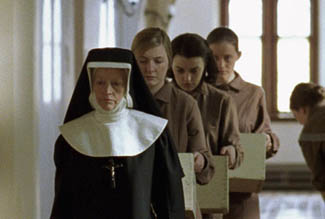
|
The Magdalene SistersBy Tad RoebuckJanuary 6, 2003
Ireland, 1964: Margaret is raped by a member of her own family at a wedding. Bernadette enjoys the attentions of local schoolboys. Rose gives birth to a child out of wedlock. What do these three young women have in common? Why, they're all going to Hell, of course. And it is estimated that nearly 30,000 other Irish women in similar situations were virtually disowned by their families, ripped out of their own lives, and shipped off to "Magdalene Asylums" to save their lost souls. Run by Catholic nuns and ostensibly set up to help wash away the "sins" of "fallen" women, Magdalene Asylums were essentially slave labor camps where the only thing getting washed was the laundry of area hotels. Subject to regular psychological, physical and sexual abuse, the women who landed in Magdalene Asylums were not being saved from Hell - they were thrown right in the middle of it. One such asylum is the setting of The Magdalene Sisters, the controversial new drama by writer/director Peter Mullan. And as with so many films before this one, the Vatican has inadvertently done their part to maximize The Magdalene Sisters' publicity. Before screening at the 59th Venice Film Festival (the world's oldest), the Vatican officially denounced the film as a pack of lies through their newspaper L'Osservatore Romano. Cardinal Ersilio Tonini told reporters "I feel enormous bitterness? This isn't a truthful portrayal of the Church, and its director has made libelous statements against Catholics." What followed was something of a feeding frenzy, stoked by a European press that might not have been otherwise inclined to pay as much attention to such a small Irish independent film. The Magdalene Sisters went on to take the fest's Golden Lion award for Best Film, and has been picked up by Miramax for wider release in early 2003. Meanwhile, the film's growing audience is left to wonder what is more shocking: the fact that such medieval institutions were allowed to exist in modern society (the last one closed in 1996); or that, in the face of overwhelming evidence to the contrary, people are being asked to accept the idea that none of it happened. At the very backbone of the film is Geraldine McEwan's performance as Sister Bridget, the iron-fisted matriarch who rules the roost. Such a role can drag an entire film down into mere camp if the actress is over-the-top; Alternatively, she can also drag it into obscurity if she brings only a small amount of weight to throw around; however, McEwan immediately establishes that the weight Sister Bridget brings to bear has the force of her God behind it. Moreover, we instantly understand her weight will suffocate the will of any woman abandoned to her "care." The Magdalene Sisters is the first film credit for a good deal of the young cast, and while Eileen Walsh is billed well below her peers, it is her performance as the tragic Crispina that stands out as the most memorable. That has as much to do with Mullan's scriptwriting as it does with Walsh's acting, as Crispina is the least static character in the film. We watch with great sympathy as this good-natured woman is slowly driven to insanity, but while this standout performance is being played out, the opportunity for Mullan to create a fine ensemble drama goes overlooked. Either despite or because of a script does not give them much room to grow, the remaining cast members manage to turn in remarkably nuanced performances. Nora-Jane Noone as Bernadette, for example, brings a deep undercurrent to her character's anger, and subtlety to even her most intense moments. On the other hand, Dorothy Duffy as Rose and Anne-Marie Duff as Margaret can only bring subtlety to their roles, as they are woefully underused. We are not allowed to care much for their particular characters, and are put in the strange position of feeling that their freedom is a bit of an anti-climax. "Subtlety," on the other hand, is this film's saving grace, and keeps "The Magdalene Sisters" from becoming an unrelenting, two-hour Parade Of Horribles. Mullan's eye and ability to balance the film's mood nearly compensate for the shortcomings of his script. At one point, for example, a woman who discovers a way to escape the asylum chooses instead to remain. The images in that silent scene - of Ireland's gorgeous countryside cast against the rot of a repressive institution - convey the psychological forces working against the inmates much more effectively than any line of dialogue. One gets the sense that life on the outside - as pariahs of their communities, as outcasts of their own families - may not have been much more bearable. There are other points to ponder, even for those who did not have Magdalene Asylums in their own backyard: At what point do our institutions stop serving and start enslaving? Why do even the freest societies still find ways to make life miserable for those who fail to live up to arbitrary, ill-defined standards? And on what authority are such reprisals so capriciously dished out? While the deeper questions raised by the film make the leap across cultures, The Magdalene Sisters, like the institution it indicts, is still very much a product of its homeland. As such, American audiences are more likely to hear about this film than they are to see it. Either way, the film makers were looking to increase awareness above all - and they have succeeded.
|
Friday, December 26, 2025
© 2006 Box Office Prophets, a division of One Of Us, Inc.